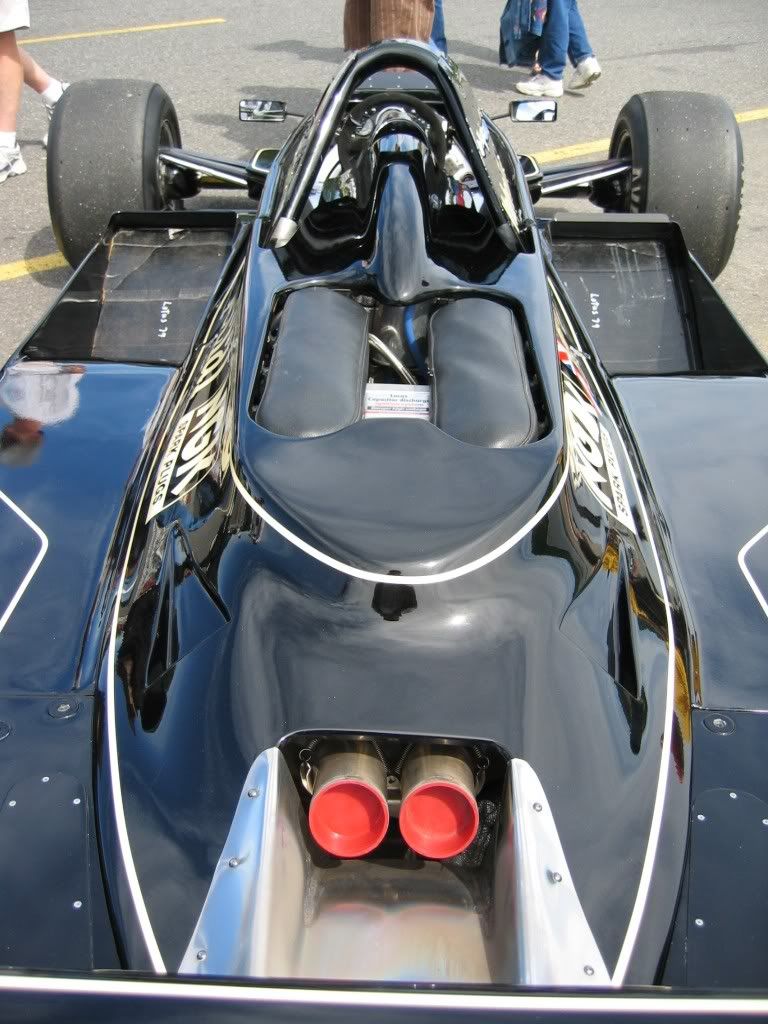Bingo! You are correct, sir!
From Wikipedia, the free encyclopedia
The Lotus 79 was a Formula 1 car designed in late 1977 by Colin Chapman, Martin Ogilvie, Tony Rudd and Peter Wright of Lotus. It was the first F1 car to take full advantage of ground effects aerodynamics, pioneered in its immediate predecessor, the Lotus 78. The undercar pressure problems in the 78 were resolved with the 79, with further design work on the venturi tunnels under the car. This allowed a smaller rear wing to be designed, causing less drag. The car was powered by the Ford Cosworth DFV and constructed of sheet aluminium honeycomb, specially strengthened for the pressures exerted on the car by the ground effects. The fuel tank was one single cell behind the driver, as opposed to separate fuel tanks as on the 78. This had the advantage of increasing fire protection and moving the centre of gravity to the middle of the car, helping cornering and braking. The 79 was also the first F1 car to be designed using wind tunnel and computer design aids. In fact it was the first F1 car to use computers to analyse it in the pits on race weekends.
The car was tested in secret throughout late 1977 by Ronnie Peterson. The car proved to be very fast, but the chassis fatigued extremely quickly due to the extreme g-forces imposed on it. The 79 produced about 30% more downforce than the 78, something not foreseen by Ogilvie and Rudd, who went back to the drawing board. The chassis was strengthened and the car was found to be even faster than before. Nicknamed 'Black Beauty' by the press and F1 fans alike, for its graceful design and sleek profile and its black and gold livery through sponsorship by John Player Special cigarettes, the Lotus 79 was instantly competitive on its debut, the Belgian Grand Prix at Zolder. It took pole at the hands of Mario Andretti by more than a second, and won the race comfortably. Andretti said after driving the 79 for the first time that the Lotus 78 was like driving a London bus. He did however have reservations over the car's brakes, which faded noticeably over a race distance.
The 79 proved to be almost unbeatable during 1978 and provided an unprecedented level of domination. The car took 6 more victories during the season, giving the drivers' championship to Andretti, and the constructors' championship to Lotus. Its only serious rivals during the season were the Ferrari 312T3 and the Brabham BT46B 'fancar'. The fan car only raced once, winning the 1978 Swedish Grand Prix, before the CSI banned the concept.[1] Meanwhile, the Ferraris only won when the Lotus failed to finish. So superior was the Lotus, that most races became a scrap for minor placings. Andretti was comfortably world champion in 1978, and Peterson finished second, although posthumously as he was tragically killed in a startline crash at Monza, ironically, the race Andretti wrapped up the championship at.
In 1979, the 79 was to be replaced by the Lotus 80, intended to be the next step in the evolution of ground effects. Martini Racing replaced JPS as sponsor in that year. The 80 proved to be a total failure and Lotus was forced to go back to the 79, driven by Andretti and Carlos Reutemann. Unfortunately the next generation in ground effects cars led first by Ligier, then Ferrari 312T4 and then Williams FW07, outclassed the 79. Although the car was updated, it was retired at the end of the 1979 season, without winning any further races.
In its lifetime, the 79 took 7 wins, 10 pole positions, 121 points and won the last drivers' and constructors' world championships for Lotus.

